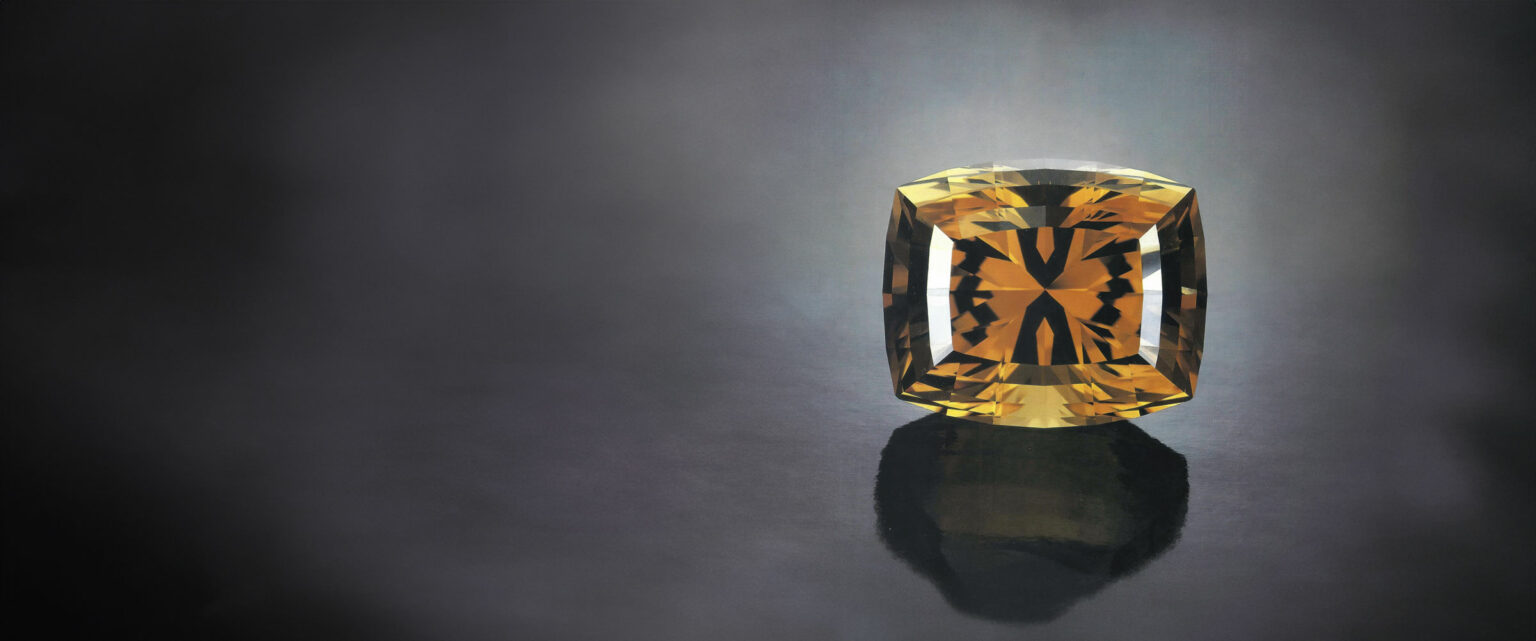Although it gets so little respect from mainstream dealers it could be Rodney Dangerfield’s birthstone, smoky quartz boasts a small, fervent following among cutters and collectors. Even so, jeweler acceptance of this abundant brown gem remains what it has always been: an uphill battle.
But, then again, uphill battles are something deposits of smoky quartz are used to. Literally. Since many deposits of this gem are found at high altitudes, quartz hounds often risk, and sometimes lose, their lives in dangerous pursuit of a gem for which they are usually paid pennies per carat in its un-hewn form. One of the most desirable strains of smoky, as some call it, occurs in the Swiss Alps where miners must be mountain climbers willing to hang on ropes thousands of feet in the air while they search for quartz veins along rock walls or dig for crystals once deposits are found.
Conditions are a tad less hazardous on the well-combed cliffs of Scotland’s Cairngorm mountain. There, intrepid quartz lovers poke and pick from the remaining specimens from the world’s most prized pockets of smoky quartz. But for all their bravery, these mountaineers usually face a comedown of meager rewards relative to the risks. That is why some cutters think these crystal gatherers are in it mostly for the adventure.
This isn’t to say that foraging for smoky quartz can’t provide a decent living. But the trick of making money with it lies in milking the typically wide spreads between its rough and ready states. When all is said and done, smoky quartz is perhaps the lapidary world’s ultimate value-added gem, 99.9% of its worth often stemming from the cutting artistry it inspires. This fact of life enables a Canadian geologist stationed on Baffin Island, 500 miles north of the Arctic Circle, to charge locals $50 per carat—big bucks for smoky quartz—by sending crystals he finds there to soft-stone specialist Art Grant, Hannibal, N.Y., then selling the well-wrought end-results as native gem material.
Meanwhile, as influential cutters like Grant and world-renowned sculptors like Michael Dyber, Rumney, N.H., begin to derive incomes from smoky quartz, their work slowly earns respect for this gem from the establishment.
Learning Curves
It isn’t as necessary as it once was to proselytize on behalf of smoky quartz among the lapidary world’s young bloods. For years, they have seen this gem as an essential medium in which to first learn the basics of their craft and then refine and personalize it. Cutter Arthur Anderson, Ashland, Ore., says he does not know how he would have developed his unique style if it weren’t for the plenitude of large, flawless and affordable rock and smoky quartz crystals.
“I design cuts in clear quartz, then try them out in smoky quartz to see the influence of color,” Anderson explains. “There is really nothing else as abundantly available to the cutter as quartz both for experiments and finished creations. When you’ve worked as much with this gem as I have, you begin to develop a deep affection for it.”
Anderson, whose art involves subtle optical effects, uses large crystals that allow him to create roomy interior panoramas reflecting light by combining curved and frosted facets. “These facet designs work especially well with the browns of smoky quartz,” he notes.
Sculptor Michael Dyber not only works in smoky quartz, he has developed a whole esthetic for its use. This esthetic seeks to exploit the most famous internal feature of this stone, called a “phantom,” which is the outline of an earlier growth phase within the crystal. Usually this “outline” appears as V-shaped color bandings, called “color-zone chevrons,” to the naked eye. Less frequently, there will be phantoms of other minerals such as calcite and chlorite.
Years ago, says Michael Randall, Crystal Reflections, San Anselmo, Calif., phantoms were considered blemishes. So cutters would try to minimize them. Today, they’re considered things of beauty, so cutters highlight them.
Cutter Michael Dyber goes even further. “Phantoms are seeds for creativity that can give a visual direction to a carving,” he says. Thus they function as a principal element in his smoky quartz sculptures where their presence is deliberately heightened for dramatic effect.
But even when Dyber doesn’t have phantoms to exploit, he can vary the thickness of pieces to create striking variations in tone and produce equally striking optical refractions. What’s more, he adds, some crystals from Madagascar combine the colors of smoky quartz and amethyst and let the cutter achieve spectacular bi-color effects.
Roughing It
While smoky quartz has proved itself to the rising generation of lapidaries, it has yet to prove itself to older generations who still think of it as a drab-brown stone that used to be sold as smoky topaz to unsuspecting consumers. Today, says Randall, smoky topaz is “taboo nomenclature” and has practically disappeared from use in jewelry stores.
Meanwhile, smoky quartz struggles for respect. Thankfully, Max Bauer, one of the most poetic gemologists to ever put pen to paper, was a fan of this gem. In his masterpiece, “Precious Stones,” published in 1896, he lauded it for “its deep rich color…[that] ranges from clove-brown to smoke-grey, passing by imperceptible stages to the perfect colourlessness of rock-crystal, and, on the other hand, through darker and darker shades till we reach specimens which, at any rate, in thick pieces, are almost perfectly black,” Dark smoky quartz, Bauer noted, is called “morion,” a term occasionally used today. Stones with vibrant colors are sometimes called “cairngorm,” a homage to the much-praised Scottish locality said to have produced the finest smoky quartz the world has ever seen. At their best, Scottish stones possess a deep reddish-brown color that Grant likens to cherry wood. Unfortunately, Scotland is exhausted as a source of smoky quartz. “I have not seen any new pieces in more than a decade,” says Randall.
Replacing Scotland as the most revered source of smoky quartz is Switzerland, whose much-worked Alpine find in the Tiefengletscher area in the canton of Uri is still producing nearly 130 years after its discovery. Fine Swiss stones, which are common in 10- to 20-carat sizes, have considerable red and orange flashes which allow them to fetch up to $30 per carat in top grades. If that strikes you as too much to pay for a smoky quartz, stones from Brazil—no doubt the world’s leading producer of this gem—are readily available for $1 to $2 per carat in a wide range of colors from tawny to root beer. But intricate faceted pieces and sculptures that qualify as art works cost more.
Please note: this profile was originally published in 1988 in Modern Jeweler’s ‘Gem Profiles: The First 60’, written by David Federman with photographs by Tino Hammid.
The 462.4-carat smoky quartz shown in the header image is courtesy of John Bradshaw, Nashua, N.H.






